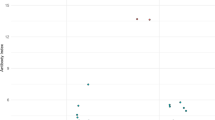Abstract
A hybridoma panel producing monoclonal antibodies to immunochemically nonidentical anti-genic epitopes of a protein nature located in the outer membrane of Yersinia pseudotuberculosis was obtained. It was revealed that the previously identified B-antigen that protects laboratory animals from experimental plague being used for active immunization was detected using monoclonal antibodies both against the men-tioned protein determinants and determinants of lipopolysaccharide O-side chains. B-antigen is a compo-nent of the Y. pseudotuberculosis outer membrane, which is egested in the form of vesicles (OMVs) by bacteria cultivated in a fluid nutrient medium.
Similar content being viewed by others
References
Carniel, E., Evolution of pathogenic Yersinia, some lights in the dark, Adv. Exp. Med. Biol., 2003, vol. 529, pp. 3–12.
Titball, R.W. and Williamson, E.D., Second and third generation plague vaccines, Adv. Exp. Med. Biol., 2003, vol. 529, pp. 397–406.
Byvalov, A.A., Darmov, I.V., Evstigneev, V.I., and Pimenov, E.V., Identification and isolation of the anti-gen that protects guinea pigs from the experimental plague, Probl. Osobo Opasnykh Infekts., 2005, vol. 89, pp. 54–58.
Byvalov, A.A., Krupin, V.V., and Gavrilov, K.E., Immu-nogenicity of the B antigen in experimental plague and pseudotuberculosis of laboratory animals, Zh. Mikro-biol. Epidemiol. Imunol., 2006, vol. 3, pp. 49–53.
Feodorova, V.A., Samelija, J.G., and Devdariani, Z.L., Heat-stable serogroup-specific proteins of Yersinia pseudotuberculosis, J. Med. Microbiol., 2003, vol. 52, no. 5, pp. 389–395.
Jain, R., Tuteja, U., and Batra, H.V., Characterization and utilization of monoclonal antibodies reactive to Yersinia pseudotuberculosis, Southeast. Asian J. Trop. Med. Publ. Hlth., 2003, vol. 34, no. 4, pp. 839–844.
Zhao, T., Zhao, P., and Doyle, M.P., Detection and isolation of Yersinia pestis without fraction 1 antigen by monoclonal antibody in foods and water, J. Food Prot., 2012, vol. 75, no. 9, pp. 1555–1561.
Byvalov, A.A., Elagin, G.D., Pechenkin, D.V., Ere-menko, Yu.D., Lobastov, V.S., and Borisevich, I.V., Obtaining and characterization of monoclonal anti-bodies to the Yersinia pseudotuberculosis lipopolysac-charide, Biotekhnologiya, 2010, vol. 3, pp. 78–83.
Westphal, O. and Jan, K., Bacterial lipopolysaccha-rides, Meth. Carbohydr. Chem., 1965, vol. 5, pp. 83–91.
Byvalov, A.A., Dudina, L.G., Litvinets, S.G., Novi-kova, O.D., Khomenko, V.A., Portnyagina, O.Yu., and Ovodov, Yu.S., Study of Yersinia pseudotuberculosis sur-face antigen epitopes using monoclonal antibodies, Appl. Biochem. Microbiol., 2014, vol. 50, no. 2, pp. 179–186.
Laemmly, U.K., Cleavage of structural proteins during the assembly of the head of bacteriophage T4, Nature, 1970, vol. 227, no. 5259, pp. 680–685.
Tsai, C.-M. and Frasch, C.E., A sensitive silver train for detecting lipopolysaccharides in polyacrylamide gels, Anal. Biochem., 1982, vol. 119, no. 1, pp. 115–119.
Hitchcock, P.J. and Brown, T.M., Morphological het-erogeneity among Salmonella lipopolysaccharide chemotypes in silver-stained polyacrylamide gels,J. Bacteriol., 1983, vol. 154, no. 1, pp. 269–277.
Skurnik, M., Molecular genetics, biochemistry and biological role of Yersinia lipopolysaccharide, Adv. Exp. Med. Biol., 2003, vol. 529, pp. 187–197.
Skurnik, M., Peippo, A., and Ervela, E., Characteriza-tion of the O-antigen gene clusters of Yersinia pseudot-uberculosis and the cryptic O-antigen gene cluster of Yersinia pestis shows that the plague bacillus is most closely related to and has evolved from Y. pseudotuber-culosis serotype O:1b, Mol. Microbiol., 2000, vol. 37, no. 2, pp. 316–330.
Lu, Q., Wang, J., Faghihnejad, A., Zeng, H., and Liu, Y., Understanding the molecular interactions of lipopolysaccharides during E. coli initial adhesion with a surface forces apparatus, Soft Matter, 2011, vol. 20, pp. 1–15.
Kulp, A. and Kuehn, M., Biological functions and bio-genesis of secreted bacterial outer membrane vesicles, Annu. Rev. Microbiol., 2010, vol. 64, pp. 163–184.
Murphy, K., Park, A.J., Hao, Y., and Brewer, D., Influ-ence of lipopolysaccharides on biofilm development and outer membrane vesicles biogenesis Pseudomonas aerugenosa PAO1, J. Bacteriol., 2014, vol. 196, pp. 1306–1317.
Author information
Authors and Affiliations
Corresponding author
Additional information
Original Russian Text © A.A. Byvalov, L.G. Dudina, A.V. Chernyad’ev, I.V. Konyshev, S.G. Litvinets, Yu.S. Ovodov, 2015, published in Molekulyarnaya Genetika, Mikrobiologiya i Virusologiya, 2015, No. 2, pp. 32–38.
Deceased
About this article
Cite this article
Byvalov, A.A., Dudina, L.G., Chernyad’ev, A.V. et al. Immunochemical activity of the Yersinia pseudotuberculosis B-antigen. Mol. Genet. Microbiol. Virol. 30, 93–100 (2015). https://doi.org/10.3103/S0891416815020032
Received:
Published:
Issue Date:
DOI: https://doi.org/10.3103/S0891416815020032




